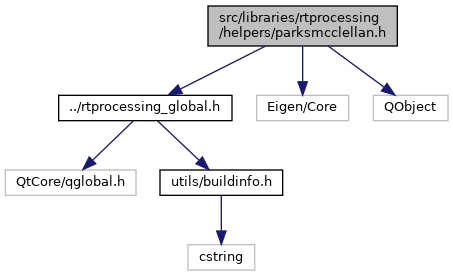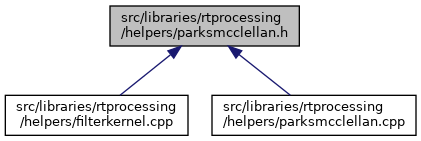|
MNE-CPP
0.1.9
A Framework for Electrophysiology
|
|
MNE-CPP
0.1.9
A Framework for Electrophysiology
|


Go to the source code of this file.
Classes | |
| class | RTPROCESSINGLIB::ParksMcClellan |
| The ParksMcClellan class provides the ParksMcClellan filter desing algorithm. More... | |
ported to mne-cpp by Christoph Dinh and Florian Schlembach in February, 2014
October 19, 2013 From: http://www.iowahills.com/A7ExampleCodePage.html
The original fortran code came from the Parks McClellan article on Wikipedia. http://en.wikipedia.org/wiki/Parks%E2%80%93McClellan_filter_design_algorithm
This code is quite different from the original. The original code had 69 goto statements, which made it nearly impossible to follow. And of course, it was Fortran code, so many changes had to be made regardless of style.
Our first step was to get a C version of the code working with as few changes as possible. Then, in our desire to see if the code could be made more understandable, we decided to remove as many goto statements as possible. We checked our work by comparing the coefficients between this code and our original translation on more than 1000 filters while varying all the parameters.
Ultimately, we were able to reduce the goto count from 69 to 7, all of which are in the Remez function. Of the 7 remaining, 3 of these are at the very bottom of the function, and go back to the very top of the function. These could have been removed, but our goal was to clarify the code, not restyle it, and since they are clear, we let them be.
The other 4 goto statements are intertwined in a rather nasty way. We recommend you print out the Remez code, tape the sheets end to end, and trace out the goto's. It wasn't apparent to us that they can be removed without an extensive study of the code.
For better or worse, we also removed any code that was obviously related to Hilbert transforms and Differentiators. We did this because we aren't interested in these, and we also don't believe this algorithm does a very good job with them (far too much ripple).
We added the functions CalcCoefficients() and ErrTest() as a way to simplify things a bit.
We also found 3 sections of code that never executed. Two of the sections were just a few lines that the goto's always went around. The third section represented nearly half of the CalcCoefficients() function. This statement always tested the same, which never allowed the code to execute. if(GRID[1] < 0.01 && GRID[NGRID] > 0.49) KKK = 1; This may be due to the 0.01 minimum width limit we set for the bands.
Note our use of MIN_TEST_VAL. The original code wasn't guarding against division by zero. Limiting the return values as we have also helped the algorithm's convergence behavior.
In an effort to improve readability, we made a large number of variable name changes and also deleted a large number of variables. We left many variable names in tact, in part as an aid when comparing to the original code, and in part because a better name wasn't obvious.
This code is essentially straight c, and should compile with few, if any changes. Take note of the 4 commented lines at the bottom of CalcParkCoeff2. These lines replace the code from the original Ouch() function. They warn of the possibility of convergence failure, but you will find that the iteration count NITER, isn't always an indicator of convergence problems when it is less than 3, as stated in the original Fortran code comments.
If you find a problem with this code, please leave us a note on: http://www.iowahills.com/feedbackcomments.html
Definition in file parksmcclellan.h.
 1.8.17
1.8.17